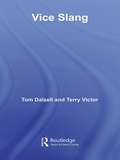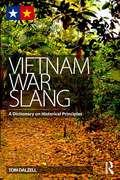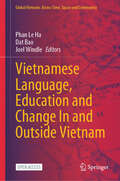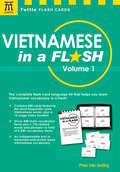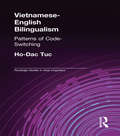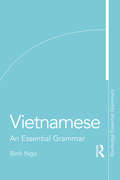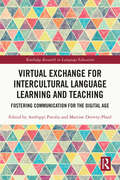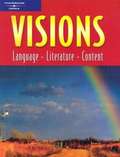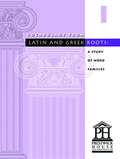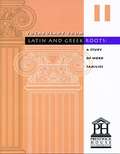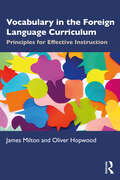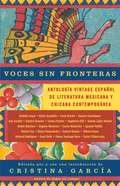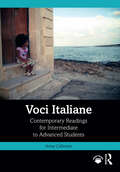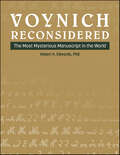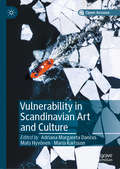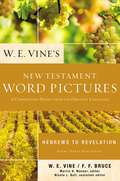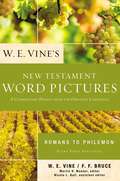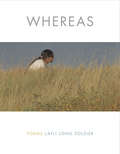- Table View
- List View
Vice Slang
by Tom Dalzell Terry VictorAre you a bit of a chairwarmer? Do you use the wins from a country straight to get scudded on snakebite in a blind tiger? Do you ride the waves on puddle or death drop? Vice Slang gently eases you into the language of gambling, drugs and alcohol, providing you with 3,000 words to establish yourself firmly in the world of corruption and wickedness. All words are illustrated by a reference from a variety of sources to prove their existence in alleys and dives throughout the English speaking world. This entertaining book will give you hours of reading pleasure.
Vietnam War Slang: A Dictionary on Historical Principles
by Tom DalzellIn 2014, the US marks the 50th anniversary of the Gulf of Tonkin Resolution, the basis for the Johnson administration’s escalation of American military involvement in Southeast Asia and war against North Vietnam. Vietnam War Slang outlines the context behind the slang used by members of the United States Armed Forces during the Vietnam War. Troops facing and inflicting death display a high degree of linguistic creativity. Vietnam was the last American war fought by an army with conscripts, and their involuntary participation in the war added a dimension to the language. War has always been an incubator for slang; it is brutal, and brutality demands a vocabulary to describe what we don’t encounter in peacetime civilian life. Furthermore, such language serves to create an intense bond between comrades in the armed forces, helping them to support the heavy burdens of war. The troops in Vietnam faced the usual demands of war, as well as several that were unique to Vietnam – a murky political basis for the war, widespread corruption in the ruling government, untraditional guerilla warfare, an unpredictable civilian population in Vietnam, and a growing lack of popular support for the war back in the US. For all these reasons, the language of those who fought in Vietnam was a vivid reflection of life in wartime. Vietnam War Slang lays out the definitive record of the lexicon of Americans who fought in the Vietnam War. Assuming no prior knowledge, it presents around 2000 headwords, with each entry divided into sections giving parts of speech, definitions, glosses, the countries of origin, dates of earliest known citations, and citations. It will be an essential resource for Vietnam veterans and their families, students and readers of history, and anyone interested in the principles underpinning the development of slang.
Vietnamese Language, Education and Change In and Outside Vietnam (Global Vietnam: Across Time, Space and Community)
by Dat Bao Phan Le Ha Joel WindleThis open access edited book attempts to break new ground in investigating multiple facets of Vietnamese language, education and change in global contexts, engaging with global Vietnam through complex lenses of language and education. Issues of language, globalization, and global identities have often been framed through the lens of hierarchical/binary power relations, and/or through a dichotomy between hyper-central languages, such as English, and revisualized or marginalized local language and cultures. In this book, this dichotomy is turned on its head by considering how Vietnam and Vietnamese are constructed in and outside Vietnam and enacted in global spaces of classrooms, textbooks, student mobility, community engagement, curriculum, and intercultural contacts. Vietnamese is among the world’s most spoken languages and is ranked in the top 20th in terms the number of speakers. Yet, at the same time, as a ‘peripheral’ or ‘southern’ global language as often seen in the Global North-Global South spectrum, the dynamics of multilingual and multicultural encounters involving Vietnamese generate distinctive dilemmas and tensions, as well as pointing to alternative ways of thinking about global phenomena from a fresh angle. Rather than being outside of the global, Vietnamese - like many other ‘non-central’ global languages - is present in diasporas, commercial, and transnational structures of higher education, schooling, and in the more conventional settings of primary and secondary school, in which visions of culture and language also evoke notions of heritage and tradition as well as bring to the fore deep seated ideological conflicts across time, space, communities, and generations. Relevant to students and scholars researching language, education, identity, multiculturalism, and their intersections, particularly related to Vietnam, but also in Southeast Asia and beyond, this volume is a pioneering investigation into overlooked contexts and languages from a global, southern-oriented perspective."This book presents an eclectic collection of 15 chapters unified by an interest in developing and teaching the Vietnamese language. To my knowledge, there has been no previous attempt to make the national language of Vietnam a focus for as many perspectives as are documented in the book. In this regard, the book makes an original and intriguing contribution to the literature on Vietnamese culture, including the culture of Vietnam’s expanding diaspora. The book is pioneering in the extent to which it draws attention to the many roles played by a national language in a nation’s political, social and cultural development. It also documents the challenges of preserving a national language in settings where it is at risk of being marginalized. It is pleasing that so many of the contributing authors are young Vietnamese scholars who can provide a distinctly Vietnamese perspective on concepts and practices of global significance."- Dr. MartinHayden, Emeritus Professor of Higher Education, Southern Cross University, Australia "Vietnamese Language, Education and Change In and Outside Vietnam brings together an excellent collection of chapters that highlight the diverse and important but under-explored roles Vietnamese language plays in different settings within and outside Vietnam. The fifteen chapters of this much needed book provide unique insights into various aspects and meanings of Vietnamese language. Collectively, the volume contributes to broadening our view about the evolution and transformation of Vietnamese language under the impacts of local, national, regional and global forces. The book invites readers to engage in a reflective and intersectional approach to rethinking and re-examining our understandings of the changes and developments of Vietnamese language over the history of the country."- Dr Ly Tran, Professor, Centre for Research for Educational Impact (REDI), Deakin University, Australia, and Founder: Australia-Vietnam
Vietnamese in a Flash Volume 1
by Phan Van GiuongVietnamese in a Flash: Volume I is an excellent new Vietnamese language learning resource for beginning students.<P><P>With a full range of features to help beginners and intermediate learners, these Vietnamese flash cards are an excellent learning tool for anyone who wants to learn Vietnamese vocabulary and master the Vietnamese language. Containing 448 flash cards of the most commonly used Vietnamese words and phrases, along with sample sentences, handy indexes and a guide to using the cards for most effective learning, Vietnamese in a Flash Volume 1 delivers. Learn 448 main words plus 1,792 related words, phrases and expressions. Pronunciation and accent marks given for all 448 main words. Arranged and sequenced in thematic groups and usage frequency.
Vietnamese-English Bilingualism: Patterns of Code-Switching (Routledge Studies in Asian Linguistics #1)
by Ho-Dac TucThis book is concerned with three central issues: the universality of constraints on code-switching, the nature of the relation between language contact and bilingualism, and the social and linguistic components that facilitate code-switching.
Vietnamese: An Essential Grammar (Routledge Essential Grammars)
by Binh NgoVietnamese: An Essential Grammar is a concise and user-friendly reference guide to modern Vietnamese. It presents a fresh and accessible description of the language in short, readable sections. Features include: Clear and up-to-date examples of modern usage. Special attention to those points which often cause problems to English-speaking learners. Vietnamese / English comparisons and contrasts highlighted throughout. The final section covers pronunciation, providing an introduction to the syllable structure of Vietnamese, and highlighting common errors made by English-speaking learners. Accompanying audio tracks for this chapter are available at www.routledge.com/9781138210707. Vietnamese: An Essential Grammar is ideal for learners involved in independent study and for students in schools, colleges, universities and adult classes of all types.
Virtual Exchange for Intercultural Language Learning and Teaching: Fostering Communication for the Digital Age (Routledge Research in Language Education)
by Anthippi Potolia Martine Derivry-PlardThis book illustrates new virtual intercultural practices for language learning from primary to tertiary education and highlights the transversality of these practices throughout the language curriculum. The current English as a Lingua Franca (ELF) perspective sets the framework as a possible vector of cultural exchanges in a variety of contexts, and from which the different authors coming from Europe and all over the world present their studies. The book deploys diverse educational exchanges within a wide range of technological tools and with varied approaches to the intercultural dimension in language learning. Through these virtual exchanges, different languages and educational cultures come together to create emerging communities of practice co-constructed for the limited time-space of the collaborative projects. This volume opens a dialogue with researchers from different backgrounds and theoretical and methodological perspectives as technology can no longer be apprehended without its purposeful human and semiotic meanings and, conversely, human and semiotic meanings can no longer be apprehended without Information and Communication Technology (ICT). Going beyond strict polarised views on the technology or humanistic approaches, this book presents a more nuanced, interrelated stance and will appeal to researchers, scholars, post graduate students, and teachers in applied linguistics, language learning and teaching, education, information studies, cultural studies, and intercultural communication.
Visions Book B: Language, Literature, Content
by Mary Lou Mccloskey Lydia StackUse this book to "grow" your English, to talk about what you write and read. Use it to learn lots of new words and new reading strategies you'll need.
Vistas: Introducción a la lengua española
by José A. Blanco Philip Redwine DonleyNIMAC-sourced textbook
Vocabulary Myths: Applying Second Language Research to Classroom Teaching
by Folse Keith S.In Vocabulary Myths, Keith S. Folse breaks down the teaching of second language vocabulary into eight commonly held myths. In debunking each myth, he introduces the myth with a story based on his 25 years of teaching experience (in the United States and abroad), continues with a presentation of what empirical research has shown on the topic, and finishes with a list of what teachers can do in their classrooms to facilitate true vocabulary acquisition. The goal of Vocabulary Myths is to foster a paradigm shift that correctly views vocabulary as fundamental in any second language learning process and demonstrates that research supports this goal-that in fact there is a wealth of empirical evidence to support these views. In addition, an important theme is that teachers have overestimated how much vocabulary students really understand, and as a result, the so-called "comprehensible input" is neither comprehensible nor input. The second language vocabulary acquisition myths reexamined in this book are: *In learning another language, vocabulary is not as important as grammar or other areas. *Using word lists to learn L2 vocabulary is unproductive. *Presenting new vocabulary in semantic sets facilitates learning. *The use of translations to learn new vocabulary should be discouraged. *Guessing words from context is an excellent strategy for learning L2 vocabulary. *The best vocabulary learners make use of one or two really specific vocabulary learning strategies. *The best dictionary for L2 learners is a monolingual dictionary. *Teachers, textbooks, and curricula cover L2 vocabulary adequately.
Vocabulary from Latin and Greek Roots: A Study of Word Families, Book 1
by Paul Moliken Elizabeth OsborneIn this etymology-based vocabulary program,units are organized by meaning rather than alphabetically and it aims to increase retention of new words as well as to expand students' vocabulary.
Vocabulary from Latin and Greek Roots: A Study of Word Families, Book 2
by Elizabeth OsborneVocabulary from Latin and Greek Roots shows students how thousands of words share common elements: roots, prefixes, and suffixes derived from Latin and Greek.
Vocabulary in the Foreign Language Curriculum: Principles for Effective Instruction
by James Milton Oliver HopwoodWritten by experts in the field, this book explains the principles of effective vocabulary instruction for the modern language classroom. While many language classrooms rely on practices which can be outdated, idiosyncratic or ill-advised, this book overviews the research and background necessary to successfully integrate vocabulary instruction into the curriculum in a systematic way. Starting with the common gaps in vocabulary instruction, Milton and Hopwood demonstrate how students’ development of a large, communicative lexicon, with an understanding of word structure and collocations, is an essential component of language instruction. The book addresses goal setting, curriculum design, word selection, how words are learned, learning in and outside of the classroom and more. It also addresses common myths about teaching vocabulary in the United Kingdom and around the world. This comprehensive text fills an important gap in the literature and is ideal for undergraduate and postgraduate courses in world language/foreign language methods and language methods courses.
Vocabulary of Soviet Society and Culture: A Selected Guide to Russian Words, Idioms, and Expressions of the Post-Stalin Era, 1953–1991
by Irina H. CortenIrina H. Corten's Vocabulary of Soviet Society and Culture is an experiment in what Soviet scholars call lingvostranovedenie--the study of a country and its culture through the peculiarities of its language. Not a conventional dictionary, Corten's lexicon is selective, offering a broad sampling of culturally significant words in the areas of politics, ideology, the economy, education, arts and letters, social problems and everyday life as well as language associated with the personalities and activities of individual Soviet leaders. The entries are listed alphabetically in English transliteration followed by the Cyrillic, although readers familiar with Russian may prefer to use the Cyrillic alphabet listing included in this volume. In each entry, the author provides a succinct but full explanation of the term and, whenever possible, cross-references to other entries, authentic examples of its use, and samples of relevant Soviet jokes. A reader may approach the lexicon either sequentially or with the aid of a subject thesaurus that divides the material into specific topics. A listing of complementary sources of reference appears in a useful bibliography. With this fascinating lexicon of "Sovietisms," Corten provides an invaluable and easily accessible medium for those general readers and scholars of the Russian language and Soviet culture interested in understanding contemporary Soviet life.Selected entries from the Vocabulary of Soviet Society and CultureAnekdótchik (anekdótchitsa) (cyrillic spelling) (n.)1: A person who tells jokes (anekdoty); 2: coll. since the late Stalin era, a person arrested and given a prison sentence for the telling of political jokes. The phenomenon indicates the important role of the political joke in Soviet culture and, specifically, in the dissident movement. See iazychnik; sident.The following jokes were popular during the Brezhnev era:1. "Comrade Brezhnev, what is your hobby?" "Collecting jokes about myself." "And how many have you collected so far?" "Two and a half labor camps."2. Question: What is a marked-down joke? Answer: A joke which, under Stalin, got you ten years in a labor camp, and now gets you only five.egoístiki (cyrillic) (n.; pl.). Lit., little egotists; coll. since the 1970s referring to headsets worn by music lovers, especially teenage fans of rock music. The idea is that, by wearing headsets, one shuts out the world and becomes indifferent to everything except oneself.zhrál'nia (cyrillic) (n.). Der. zhrat', to gorge, devour (vulg.); coll. since the 1970s denoting an eating establishment with inexpensive and often bad-tasting food. In the late 1980s, the term also has been applied to new fast-food restaurants which have been built in Soviet cities by Western concerns, for example, McDonald's. See amerikanka; stekliashka; stoiachka.
Voces sin fronteras
by Cristina GarciaA medida que los descendientes de inmigrantes mexicanos se han ido estableciendo por todo Estados Unidos, ha surgido una gran literatura, pero sus similaridades con la literatura de México han pasado inadvertidas. En Voces sin fronteras, la primera antología que combina la literatura de ambos lados de la frontera méxico-americana, Cristina García nos presenta un diálogo intercultural de una rica diversidad. Voces históricas de maestros mexicanos como Carlos Fuentes, Elena Poniatowska y Juan Rulfo se entrelazan contínuamente con voces magistrales de chicanos como Sandra Cisneros, Rudolfo Anaya y Gloria Anzalda para formar una vibrante tela bilingüe y bicultural. El resultado es esta memorable colección de obras de ficción, ensayos y poesía que brinda una perspectiva emocionantemente nueva de nuestro continente y de la mejor literatura contemporánea.
Voces sin fronteras: Antologia Vintage Espanol de literatura mexicana y chicana contemporánea
by Cristina GarcíaA medida que los descendientes de inmigrantes mexicanos se han ido estableciendo por todo Estados Unidos, ha surgido una gran literatura, pero sus similaridades con la literatura de México han pasado inadvertidas. En Voces sin fronteras, la primera antología que combina la literatura de ambos lados de la frontera méxico-americana, Cristina García nos presenta un diálogo intercultural de una rica diversidad.Voces históricas de maestros mexicanos como Carlos Fuentes, Elena Poniatowska y Juan Rulfo se entrelazan contínuamente con voces magistrales de chicanos como Sandra Cisneros, Rudolfo Anaya y Gloria Anzaldœa para formar una vibrante tela bilingüe y bicultural. El resultado es esta memorable colección de obras de ficción, ensayos y poesía que brinda una perspectiva emocionantemente nueva de nuestro continente --y de la mejor literatura contemporánea.From the Trade Paperback edition.
Voci Italiane: Contemporary Readings for Intermediate to Advanced Students
by Anna CellineseVoci Italiane: Contemporary Readings for Intermediate to Advanced Students presents intermediate to advanced students of Italian with a series of calibrated and thought-provoking readings from both contemporary Italian fiction and non-fiction. Voci Italiane exposes learners to the authentic language of 21st-century authors whose voices and work reflect and form part of the diverse sociocultural fabric of today’s Italy. The readings expose learners to authentic materials that provoke a reflection on intercultural competence, diversity, and social justice issues and are accompanied by exercises and writing activities. The contemporary and engaging topics covered include gender and race, multiculturalism and plurilingualism, disability, political upheaval, and alternative forms of authorship in art such as graffiti, street art, and underground rap. This book is ideal for intermediate and advanced learners of Italian as a foreign language seeking to expand on their knowledge and understanding of lexical and grammatical structures in Italian, with a focus on 21st-century Italy. It is suitable for use as a primary text for both class-based and independent study.
Vox Latina
by W. Sidney AllenThis is a reissue in paperback of the second edition of Professor Allen's highly successful book on the pronunciation of Latin in Rome in the Golden Age. In the second edition the text of the first edition is reprinted virtually unchanged but is followed by a section of supplementary notes that deal with subsequent developments in the subject. The author also added an appendix on the names of the letters of the Latin alphabet and a select bibliography.
Voynich Reconsidered: The Most Mysterious Manuscript in the World
by Robert H. EdwardsIn this book, Dr. Robert Edwards brings a fresh, mathematical perspective to the Voynich manuscript and sets out a strategy whereby the interested reader could extract meaning from the seemingly impenetrable symbols . . . if meaning is there to be found. The Voynich manuscript has been described as the most mysterious document in the world. In 1637, a Bohemian scholar sent a mysterious manuscript to the celebrated professor Athanasius Kircher in Rome. Kircher promised to decipher it when the mood took him. He never did. Later, antiquarian bookseller Wilfrid Voynich claimed that he had discovered it in 1912 in a castle in Europe. • Contains hundreds of bizarre illustrations that seem to represent plants, stars, animals, zodiac signs, strange receptacles, and naked women in pools and streams of green water. • Throughout its over 200 pages are strings of glyphs or symbols that look like words; but the symbols do not belong to any known living or extinct languages. • No one knows what these symbols mean—or even whether they mean anything, though hundreds of scholars have tried to decipher them for 500 years. • Today, all that we know for sure is that the parchment probably dates from the early 15th century.
Vredaman
by Unai Elorriaga Lopez de LetonaAurreko bere bi liburu arrakastatsuen ondoren (Sprako tranbia eta Van?t Hoffen ilea), nobela berri batekin dator Unai Elorriaga (Algorta, 1973): Vredaman. Aita ospitalean gaixo eta ama hura zaintzen dauzkalako osaba-izekoen etxera bidaltzen duten haurra; golf-klub baten barruan errugbi-zelai klandestino bat margotu nahi duten bi lagun; urtetan arkitekto baten andregai izan baina inoiz ezkondu ez zen emakume adindua; aitite gizon inportantea zela jakin eta haren arrastoaren atzetik dabilen gaztea. Elkarrekin nahasten diren hainbat istorio daude liburu honetan, pertsonaia ameslari, xelebre edo maitagarriz beteak, bakoitza bere estilo eta hizkera berezian kontatua: haurraren sinpletasun magikoa, atso-agureen berritsukeria patxadatsua, alprojen elkarrizketa zoroak? Jolasetik asko du eleberri honek, baina jolasetik harago gizatasun-taupadak ere nabarmenduko ditu irakurleak, amaierara hurbildu ahala emozioan goraka doan kontakizun biribil eta gozagarri honetan.
Vulnerability in Scandinavian Art and Culture
by Mats Hyvönen Adriana Margareta Dancus Maria KarlssonIn this open access book, seventeen scholars discuss how contemporary Scandinavian art and media have become important arenas to articulate and stage various forms of vulnerability in the Scandinavian welfare states. How do discourses of privilege and vulnerability coexist and interact in Scandinavia? How do the Scandinavian countries respond to vulnerability given increased migration? How is vulnerability distributed in terms of margin and centre, normality and deviance? And how can vulnerability be used to move audiences towards each other and accomplish change? We address these questions in an interdisciplinary study that brings examples from celebrated and provocative fiction and documentary films, TV-series, reality TV, art installations, design, literature, graphic art, radio podcasts and campaigns on social media.
W. E. Vine's New Testament Word Pictures: A Commentary Drawn from the Original Languages
by W. E. VineStudy the meaning of biblical words in the original languages without spending years learning Greek. W. E. Vine's New Testament Word Pictures places every key word from Vine's classic Expository Dictionary of New Testament Words in Bible book and verse-by-verse order. The text of the King James Version of the Bible is included for context, but W. E. Vine's New Testament Word Pictures is keyed to the Strong's numbering system and can be used with any Bible translation.W. E. Vine's New Testament Word Pictures:Explains key words in original Greek contextDoes not require knowledge of GreekIncludes Strong's numbers for further studyIs ideal for busy Bible preachers and teachersCombines the features of a dictionary, concordance, and commentary
W. E. Vine's New Testament Word Pictures: A Commentary Drawn from the Original Languages
by W. E. VineStudy the meaning of biblical words in the original languages without spending years learning Greek.W. E. Vine's New Testament Word Pictures places every key word from Vine's classic Expository Dictionary of New Testament Words in Bible book and verse-by-verse order. The text of the King James Version of the Bible is included for context, but W. E. Vine's New Testament Word Pictures is keyed to the Strong's numbering system and can be used with any Bible translation.W. E. Vine's New Testament Word Pictures:Explains key words in original Greek contextDoes not require knowledge of GreekIncludes Strong's numbers for further studyIs ideal for busy Bible preachers and teachersCombines the features of a dictionary, concordance, and commentary
WHEREAS: Poems
by Layli Long SoldierThe astonishing, powerful debut by the winner of a 2016 Whiting Writers' AwardWHEREAS her birth signaled the responsibility as mother to teach what it is to be Lakota therein the question: What did I know about being Lakota? Signaled panic, blood rush my embarrassment. What did I know of our language but pieces? Would I teach her to be pieces? Until a friend comforted, Don’t worry, you and your daughter will learn together. Today she stood sunlight on her shoulders lean and straight to share a song in Diné, her father’s language. To sing she motions simultaneously with her hands; I watch her be in multiple musics.—from “WHEREAS Statements”WHEREAS confronts the coercive language of the United States government in its responses, treaties, and apologies to Native American peoples and tribes, and reflects that language in its officiousness and duplicity back on its perpetrators. Through a virtuosic array of short lyrics, prose poems, longer narrative sequences, resolutions, and disclaimers, Layli Long Soldier has created a brilliantly innovative text to examine histories, landscapes, her own writing, and her predicament inside national affiliations. “I am,” she writes, “a citizen of the United States and an enrolled member of the Oglala Sioux Tribe, meaning I am a citizen of the Oglala Lakota Nation—and in this dual citizenship I must work, I must eat, I must art, I must mother, I must friend, I must listen, I must observe, constantly I must live.” This strident, plaintive book introduces a major new voice in contemporary literature.
Walker's Rhyming Dictionary of the English Language
by J. WalkerFirst published in 1983.This is a long-established standard work of reference for poets and rhymesters.
